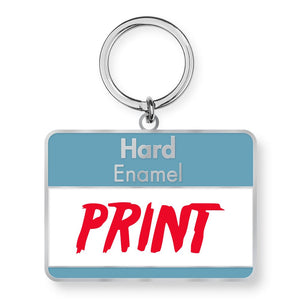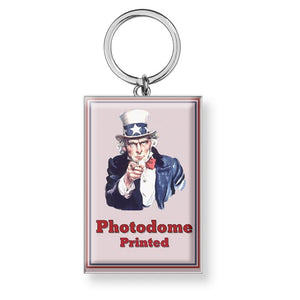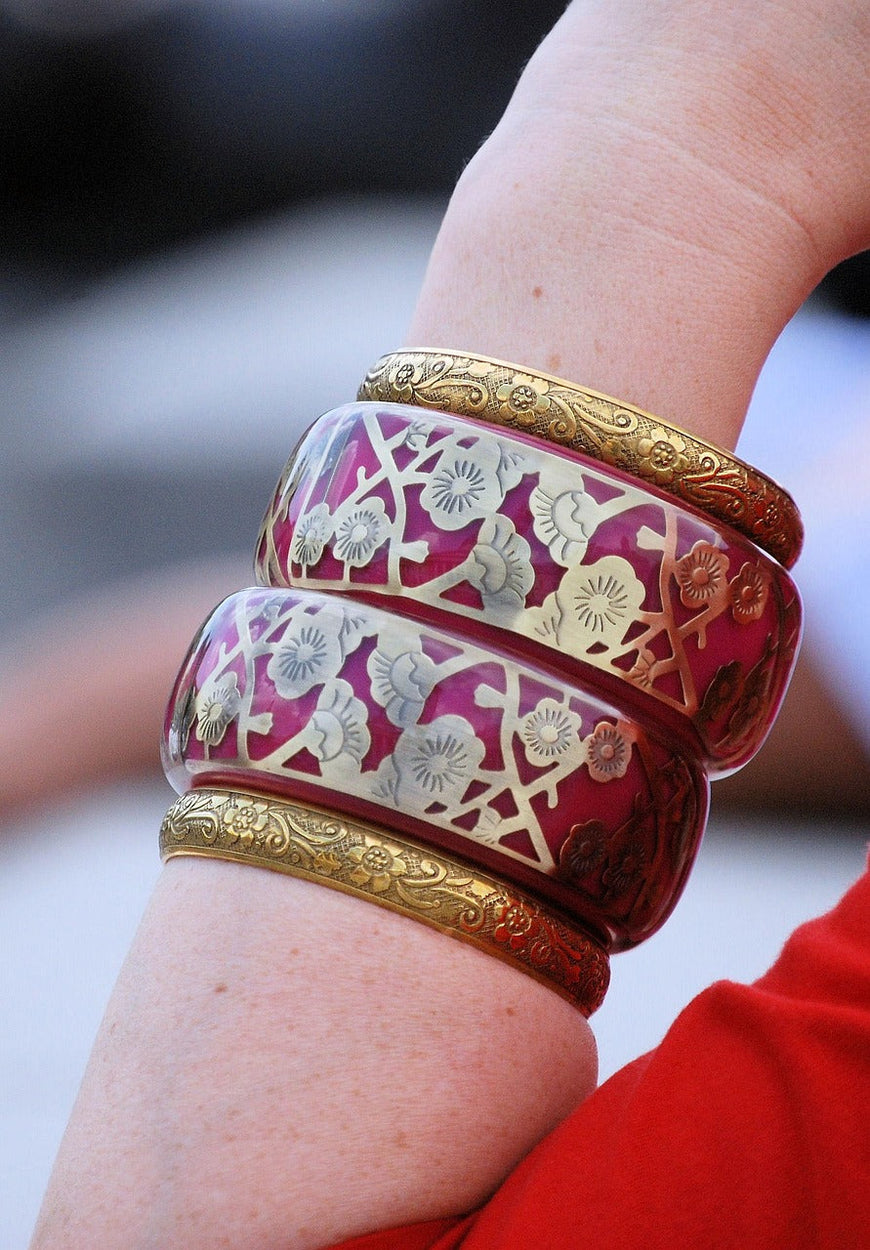Enameling is a form of decorative art often used in jewelry-making. It is most commonly used in the creation of earrings, pendants, bracelets, lapel pins, watches, and other small metal objects. It involves melding powdered glass with a metal surface through the use of high-temperature firing techniques. Enamel artwork is vibrant and smooth, with a glossy finish that is durable and resistant to wear. Over time, artisans called enamelists or enamelers have developed a variety of enameling techniques, each distinct and identifiable by how the metal is prepared or how the enamel is applied to the metal surface.
Ancient Origins of Enameling
The art of enameling can be traced back to around the 13th century B.C.E. Mycenaean goldsmiths were among the first to inlay enamel into gold rings and other items. Through early trade, civilizations and cultures around the world began to use and adapt enameling techniques to meet their needs and further their own artistic traditions.
In the 5th century B.C.E, Greek artisans began incorporating enamel into their decorative works. Enamel was used in small-scale metalwork throughout the Mediterranean during this era, and while some have speculated that enamel once adorned the famed statues of Zeus created by Phidias, there is no concrete archaeological evidence to confirm this.
Byzantine and Medieval Enameling
Between the 9th and 11th centuries C.E., cloisonné enameling became popular and widely used throughout the Byzantine Empire. This method, involving delicate gold wires forming compartments filled with enamel, was extensively used in the creation of religious icons and jewelry. Byzantine influences extended into Germany, and the cultural exchange between these regions contributed to a distinctive German enameling style. In the 12th century, the champlevé technique gained popularity in Western Europe. Enamelists carved recesses into metal surfaces and filled them with enamel, often adorning religious artifacts like reliquaries and altar pieces.
Renaissance Innovations
The Renaissance era, which spanned the 14th through 17th centuries, saw the emergence of new enameling techniques and a surge in artistic refinement. Italian goldsmith, sculptor, and writer Benvenuto Cellini was among those who employed methods such as basse-taille and plique-à-jour in their artwork. In the late 15th century in Limoges, France, a major innovation was made: The Pénicaud family pioneered painted enamel, a technique allowing colors to be applied side by side without the use of wires. This breakthrough in enameling allowed for more detailed and realistic images to be produced, including portraits and complex scenes. Renowned enamelists like Léonard Limousin and Pierre Reymond mastered this style in the 16th century.
Common Themes and Decorative Uses
Throughout history, enameling has been applied to a wide range of subjects and motifs. Religious imagery has remained a central theme, but artisans have also explored botanical designs, animals, and mythological scenes, and enamel artwork has adorned many different types of objects, including boxes, candlesticks, jewelry, and watches. By the late 16th century, miniature painted enamel was commonly featured on watch cases and in some instances served as a substitute for gemstones. One notable example is the use of garnet cloisonné in medieval jewelry, such as the treasures discovered at Sutton Hoo, an archaeological site located in Suffolk, England, that dates back to the 7th century and is considered to be among the most significant archaeological sites in British history. Modern enamel work sometimes imitates a gem-like appearance using transparent enamel layered over textured metal.
The Modern Revival and Contemporary Practice
Enameling experienced a renaissance of its own during the late 19th and early 20th centuries, thanks in part to the Arts and Crafts movement, which was a counter-movement to the industrialization of the Victorian era. This period emphasized handcrafted artistry and workmanship and leaned toward the use of natural materials and simple designs. It was during this time that enamel was reintroduced as a serious artistic medium. In the United States, educator Kenneth F. Bates was instrumental in shifting enameling from a hobbyist pursuit to a respected art form. His teaching inspired generations of enamelists to view the medium with greater ambition and creativity.
By the 1970s, schools of jewelry, arts, and crafts were training a new wave of professional enamelists. Kulicke-Stark Academy of Jewelry Arts in New York was one such school and was highly respected for its role in reviving classical goldsmithing and enameling practices. American artist Fred Ball experimented with the traditional rules of enameling and is recognized for further expanding the possibilities of enamel techniques like electrolytic etching and mixed media, challenging artists to push the boundaries of the craft.
Enameling Today
Today, enameling is taught in craft schools, universities, and art centers around the world. In the United States, the leading organization for enamelists is The Enamelist Society, which hosts biennial conferences, publishes a dedicated magazine, and encourages a global community of artists. Local enamel guilds also help sustain the tradition through workshops and exhibitions, although the number of professional enamelists remains relatively small.
How Are Enamel Pins and Jewelry Made?
There are many different enameling techniques that can be used to make enamel pins and jewelry. These techniques include:
- Basse-Taille: A technique in which a design is engraved or etched into a metal surface and then covered with translucent enamel. The varying depths create shading and dimension as the design shows through the enamel.
- Camaïeu: A variation of the grisaille technique in which white enamel is painted in monochrome over a colored enamel background (often blue or black), producing a cameo-like, highlighted effect
- Champlevé: An enameling technique in which recesses are carved or etched into a metal surface and filled with enamel. After firing, the surface is polished, exposing both the enamel and the metal design.
- Cloisonné: Thin metal wires are affixed to a metal base to form enclosed cells in this technique. The cells are filled with enamel, fired, and polished. The wires remain visible, outlining the design.
- Ginbari Foil: A Japanese technique of enameling in which silver foil is placed beneath transparent enamel. The foil reflects light, creating a luminous effect often enhanced with textures.
- Grisaille: A monochromatic painting technique using white enamel on a dark, typically black, background. Multiple layers of white enamel are applied and fired to create highlights and depth.
- Guilloché: An enameling technique that leans into technology to mechanically engrave repetitive, decorative patterns into a metal surface before covering it with transparent enamel. The engraved design shimmers beneath the enamel.
- Impasto: Enamel is applied in thick, textured layers that stand in relief from the background surface to create a three-dimensional, tactile appearance.
- Limoges: A painted enamel technique developed in Limoges, France, in which artists use enamel-like paint, layering colors to create detailed, realistic portraits and scenes without the use of metal outlines
- Plique-à-Jour: Enamel is applied to open cells in a metal framework without a backing. Once it is fired in a kiln, the enamel remains suspended, allowing light to shine through similarly to stained glass.
- Raku: Adapted from Japanese pottery, this enameling technique involves rapidly cooling enameled pieces in combustible materials after firing, resulting in unpredictable crackled or smoky surface effects.
- Sgraffito: A design is scratched into a layer of enamel before firing, revealing the contrasting enamel or metal underneath. This allows for bold line work and textural contrast.
- Silkscreen: Enamel is pushed through a mesh screen containing a design stencil, allowing for precise and repeatable patterns or text to be produced. This technique is often used in combination with other techniques.
- Stenciling: Enamel is applied through a cut-out stencil placed on the metal. The stencil is removed before firing, leaving behind sharp, clean shapes or motifs.
- Torch-Fired: Enamel is fused to metal using a handheld torch rather than a traditional kiln. This technique is favored for its flexibility in small-scale studio work, though it offers less color control.
Decorative Additives and Special Materials for Enameling
China Paints
China paints are low-fire ceramic materials that can be applied to the top surface of enamel before the piece is fired. These paints are compatible with enamel firing temperatures and allow for finer detail and color layering in decorative enamel artwork.
Overglazes and Underglazes
These glazes contain finely ground pigments and are used either over or under traditional enamel layers. Underglazes are especially effective in techniques such as basse-taille, enhancing the visibility of underlying metal textures and patterns.
Copper Screen and Pot Scrubber Mesh
Mesh elements can be used above or below transparent enamels to create interesting textures and patterns. When embedded slightly under the enamel and ground back after firing, the screen creates an effect reminiscent of woven fabric, as the process reveals highlights where warp and weft wires intersect.
Decals
Decals are pre-printed designs on specially treated paper that can be transferred to enamel, glass, wood, and other surfaces. They allow for precise and repeatable imagery in decorative applications.
Foil and Leaf
Available in fine silver, gold, and palladium, these metallic materials can be used beneath or atop enamel layers. Foil is slightly thicker than leaf and is often used for added reflectivity and brilliance in transparent enamel applications.
Gemstones
Gemstones can be set into enameled surfaces using metal bezels, adding texture and dimension to otherwise flat designs.
Granules
Granules are small balls of fine silver or high-karat gold that are used for surface embellishment. They can be granulated or fused onto a metal backing and then enameled around.
Glass Beads and Balls
Solid glass beads or balls can be fused onto enameled surfaces to add volume and color.
Lumps and Threads
"Lumps" are irregular chunks of colored glass, while "threads" are thin glass filaments in various sizes. Both can be incorporated into enameled pieces for added color and texture.
Lusters
Lusters are thin metallic color applications that, when placed on the top layer of enamel, create crackle maze effects, a web-like network of tiny lines and fractures that spread irregularly, to reveal the enamel underneath. Lusters may also appear iridescent or opalescent after firing.
Metal Embellishments
Small, shaped metal pieces can be embedded into the top layer of enamel, much like granules, to create raised decorative effects.
Millefiori
Millefiori are cross-sections of patterned glass canes known for their intricate designs. This technique, famous in Venetian glass art, is sometimes incorporated into enamel work to add detailed, colorful accents.
Unique Enameling Techniques That Combine Form and Decoration
Firescale Enameling
This technique makes artistic use of oxide buildup, called firescale, on the metal surface. Enamelists manipulate firescale by applying a holding agent, sifting transparent enamel, and building up layers to create unique line effects. Sometimes, pieces of firescale are intentionally detached and reapplied to create contrast and depth.
Separation Enameling
Separation enameling uses a special type of enamel that, when applied over another enamel layer, causes indentations and changes in color. This creates a dramatic, textured, and reactive surface.
Creative Integration
The art of enameling can use and combine any of these materials and techniques to produce unique, expressive works ranging from portraits to pins. From traditional layering to experimental textures, additives, and methods, this art form offers enamelists a world of creative possibilities.







































